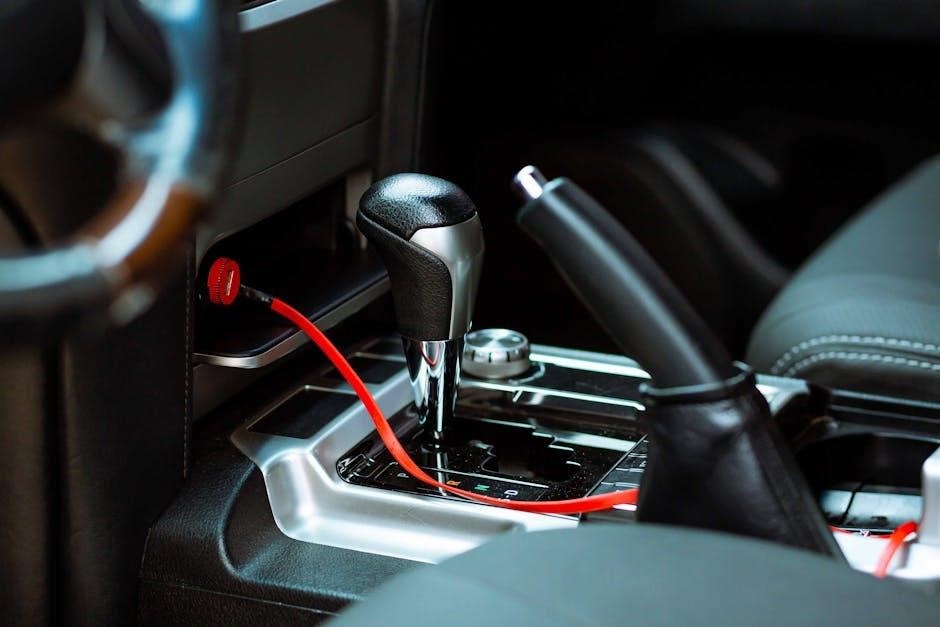Manual transmission fluid is a specialized lubricant designed to protect gears and synchronizers in manual transmissions, ensuring smooth operation and longevity. It’s essential for optimal performance.
What is Manual Transmission Fluid?
Manual transmission fluid, often referred to as gear oil, is a specialized lubricant designed specifically for manual transmissions. It is formulated to provide optimal lubrication for gears, bearings, and synchronizers, ensuring smooth shifting and protecting against wear. Unlike automatic transmission fluid, manual transmission fluid typically has higher viscosity and unique frictional properties tailored for manual systems. It also plays a role in cooling the transmission and preventing overheating. Available in various formulations like SAE 80W or 75W-90, it is essential for maintaining the health and performance of a manual transmission system.
Importance of Transmission Fluid for Manual Transmissions
Manual transmission fluid is crucial for lubricating gears, bearings, and synchronizers, preventing overheating and wear. It ensures smooth shifting and protects against corrosion and friction. Without proper fluid, the transmission can suffer severe damage, leading to costly repairs. Regular maintenance, including fluid checks and changes, is essential for optimal performance and extending the lifespan of the transmission. Fresh fluid prevents degradation and maintains the system’s reliability, making it a critical component of manual transmission care.

Types of Manual Transmission Fluid
Manual transmission fluids vary, with common types including SAE 80W, 75W-90, 80W-90, and SAE 90. Synthetic and conventional options are available, each offering unique performance benefits.
Common Formulations: SAE 80W, 75W-90, 80W-90, and SAE 90
Common manual transmission fluid formulations include SAE 80W, 75W-90, 80W-90, and SAE 90. These viscosities offer varying levels of lubrication and temperature performance. SAE 80W is thinner for colder climates, while SAE 90 is thicker for high-stress conditions. Multi-grade options like 75W-90 and 80W-90 provide balanced performance across temperature ranges. These formulations are designed to protect gears, bearings, and synchronizers, ensuring smooth shifting and durability. The choice depends on the vehicle manufacturer’s recommendations and operating conditions.
Synthetic vs. Conventional Manual Transmission Fluids
Synthetic and conventional manual transmission fluids differ in performance and durability. Synthetic fluids offer superior lubrication, better viscosity stability, and enhanced protection in extreme temperatures. They are ideal for high-performance or heavy-duty applications. Conventional fluids, while more affordable, may not perform as well in extreme conditions. Synthetic options provide longer drain intervals and better wear protection for gears and synchronizers, making them a worthwhile investment for drivers seeking optimal transmission health and longevity.
Specialized Fluids for High-Performance Applications
High-performance manual transmissions require specialized fluids designed to handle extreme conditions. These premium formulations, such as TREMEC HP-MTF and AMSOIL synthetic options, offer enhanced lubrication, thermal stability, and wear protection. They are engineered to maintain viscosity under high stress, ensuring smooth shifting and gear protection in racing or heavy-duty applications. These fluids are typically full synthetic, providing superior frictional properties and extended drain intervals compared to conventional oils. For optimal performance in demanding environments, specialized high-performance fluids are the preferred choice.

Role of Manual Transmission Fluid
Manual transmission fluid is essential for lubricating gears, cooling the system, and preventing wear on synchronizers, ensuring smooth operation and prolonging transmission life and performance.
Lubrication of Gears and Bearings
Manual transmission fluid plays a critical role in reducing friction between gears and bearings, preventing wear and tear. It ensures smooth engagement and disengagement of gears, minimizing heat buildup. The fluid coats metal surfaces, protecting them from direct contact and potential damage. Proper lubrication is essential for maintaining the integrity of transmission components and ensuring reliable performance. Without adequate lubrication, gears and bearings can overheat and degrade prematurely, leading to costly repairs. Regular fluid checks and changes are vital to uphold this protective function.
Cooling the Transmission System
Manual transmission fluid serves as a critical coolant, absorbing and dissipating heat generated by friction between gears and bearings. This prevents overheating, which can damage components and lead to premature wear. The fluid circulates through the transmission, reducing thermal stress during intense driving conditions. Proper cooling ensures consistent performance and prevents degradation of the fluid itself. Overheating can cause fluid breakdown, leading to reduced protection and potential system failure. Regular fluid maintenance is essential to maintain its cooling properties and safeguard the transmission.
Preventing Wear and Tear on Synchronizers
Manual transmission fluid plays a vital role in protecting synchronizers from wear and tear. Synchronizers, often made of soft metals like brass, are prone to damage during gear shifts. The fluid reduces friction between these components, ensuring smooth engagement and preventing excessive wear. It forms a protective layer that minimizes metal-to-metal contact, reducing the risk of damage. Neglecting fluid maintenance can lead to synchronizer failure, resulting in costly repairs and poor shifting performance. Regular fluid checks and changes are essential for preserving transmission health.
Maintenance and Care
Regular checks and timely fluid changes are crucial for manual transmission health. Always follow manufacturer guidelines to ensure optimal performance and longevity of the transmission system.
How to Check Manual Transmission Fluid Level
To check the manual transmission fluid level, locate the transmission oil filler plug, typically near the firewall. Warm the engine, then drain a small amount of fluid to test its condition and level. Use a dipstick or metal stem to measure; the level should be just beneath the filler cap. Ensure the vehicle is level for an accurate reading. Always consult your owner’s manual for specific instructions to avoid overfilling or underfilling.
When to Change Manual Transmission Fluid
Manual transmission fluid should be changed every 30,000 to 60,000 miles, depending on the vehicle and driving conditions. If you drive in extreme heat, tow heavy loads, or notice signs like discolored fluid, difficulty shifting, or unusual noises, consider changing it sooner. Always refer to your owner’s manual for specific recommendations. Fresh fluid ensures optimal gear lubrication and prevents premature wear, keeping your transmission running smoothly for years.
Draining and Refilling Procedures
Draining and refilling manual transmission fluid involves raising the vehicle, locating the drain plug, and allowing the old fluid to flow into a pan. After draining, refill with the recommended fluid type and amount specified in your owner’s manual. Use a funnel to prevent spills and ensure the fluid level reaches the designated mark. Tighten the drain plug securely, typically around 30-50 Nm, depending on the vehicle. Always double-check the manual for specific instructions to avoid overfilling or using the wrong fluid.

Differences Between Manual and Automatic Transmission Fluids
Manual and automatic transmission fluids differ in viscosity and additives. Manual fluids are thicker, like SAE 80W, for gear lubrication, while automatic fluids are thinner with friction modifiers for hydraulic operations. Using the wrong fluid can cause poor performance or damage.
Viscosity and Frictional Properties
Manual transmission fluids typically have higher viscosity, such as SAE 80W or 75W-90, to lubricate gears and bearings effectively. Automatic transmission fluids, however, are thinner and contain friction modifiers for smooth torque converter operation. Manual fluids are formulated to prevent gear wear without slip, while automatic fluids manage heat and hydraulic pressure. Using the wrong type can lead to poor shifting, overheating, or component failure, emphasizing the importance of selecting the correct viscosity for optimal performance and longevity.
Why Manual Transmissions Require Specific Fluids
Manual transmissions need specialized fluids due to their mechanical demands. Unlike automatics, manuals lack torque converters, so they don’t require fluids with friction modifiers. Instead, manual-specific fluids focus on lubricating gears and bearings, often with higher viscosities like SAE 80W or 75W-90. These fluids ensure proper lubrication without the need for hydraulic pressure management, maintaining smooth shifting and preventing wear. Using incorrect fluids can lead to poor performance, overheating, or damage, highlighting the importance of selecting the right fluid for manual transmissions.
Consequences of Using the Wrong Fluid
Using incorrect fluid in a manual transmission can lead to poor lubrication, causing gears and bearings to wear prematurely. It may also result in difficulty shifting, overheating, or even complete transmission failure. Additionally, incompatible fluids can damage synchronizers and seals, leading to costly repairs. Proper fluid selection is critical to ensure smooth operation, prevent damage, and maintain the longevity of the transmission system. Always refer to the manufacturer’s recommendations to avoid such issues.

Application and Compatibility
Always consult your vehicle’s manual for specific fluid recommendations. Manual transmissions require fluids compatible with their gear and synchronizer materials to ensure optimal performance and longevity.
Vehicle-Specific Recommendations
Always consult your vehicle’s manual for specific transmission fluid recommendations, as requirements vary by manufacturer and model. For example, Honda may specify ATF, while others like BMW or Ford might recommend synthetic MTF. Using the wrong fluid can lead to poor performance or damage. Some vehicles, such as the Cadillac CT4-V Blackwing, use ATF despite being manual, highlighting the importance of adhering to manufacturer guidelines. Popular brands like AMSOIL, Valvoline, and TREMEC offer fluids tailored for specific applications, ensuring compatibility and optimal performance.
Compatibility with Synchronizers and Gears
Manual transmission fluid must be compatible with synchronizers and gears to ensure smooth shifting and prevent wear. SAE 75W-90 and 80W-90 are common choices, offering optimal viscosity for lubrication without excessive friction. Synchronizers, often made of soft metals like brass, require fluids that prevent wear while maintaining proper frictional properties. Incompatible fluids can cause degradation or damage, leading to costly repairs. Always select fluids formulated for your specific transmission type to maintain performance and longevity.
Using ATF in Manual Transmissions: Pros and Cons
Using automatic transmission fluid (ATF) in manual transmissions is unconventional but seen in some high-performance vehicles like the Cadillac CT4-V Blackwing. ATF can provide smoother shifting and better frictional properties in specific cases. However, it may not offer the same protection for gears and synchronizers as dedicated manual transmission fluids. Misuse can lead to increased wear and overheating. Always consult the manufacturer’s recommendations to avoid compatibility issues and ensure optimal performance.

Popular Brands and Products
Top brands include AMSOIL, Valvoline, and TREMEC, offering high-quality manual transmission fluids. AMSOIL provides synthetic options, while Valvoline’s Synchromesh is popular for Chrysler models. TREMEC’s HP-MTF excels in high-performance applications.
AMSOIL Synthetic Manual Transmission Fluid
AMSOIL Synthetic Manual Transmission Fluid is a premium, full-synthetic lubricant designed for exceptional protection and performance in manual transmissions. It provides superior wear protection, smooth shifting, and resistance to thermal degradation. Formulated for extreme conditions, it ensures consistent viscosity and frictional properties, reducing gear noise and overheating. Compatible with brass synchronizers and a wide range of gear materials, it extends transmission life and maintains optimal performance. Ideal for high-demand applications, AMSOIL synthetic fluid offers extended drain intervals and unparalleled reliability.
Valvoline Synchromesh Manual Transmission Fluid
Valvoline Synchromesh Manual Transmission Fluid is a high-performance lubricant designed to meet the demands of manual transmissions. It is formulated with advanced friction-modified additives to ensure smooth, precise shifting and optimal gear protection. Compatible with a wide range of vehicles, including those requiring Chrysler MS-9224 specifications, it provides excellent wear resistance and thermal stability. This fluid is ideal for drivers seeking reliable performance, reduced gear noise, and extended transmission life in both everyday and high-stress driving conditions.
TREMEC HP-MTF High-Performance Fluid
TREMEC HP-MTF High-Performance Fluid is specifically formulated for manual transmissions requiring exceptional protection and responsiveness. Designed for high-performance applications, it provides an ideal balance of rugged protection and smooth shifting. This fluid excels in extreme conditions, such as racing or heavy-duty use, by maintaining consistent viscosity and preventing wear on gears and synchronizers. Its advanced additives ensure optimal friction control and thermal stability, making it a top choice for drivers seeking peak transmission performance and durability.

DIY Guide to Changing Manual Transmission Fluid
A DIY guide to changing manual transmission fluid involves gathering tools, draining the old fluid, and refilling with the recommended type. Ensure proper disposal of used fluid for environmental safety.
Tools and Materials Needed
To change manual transmission fluid, you’ll need a socket set, drain pan, new fluid filter (if applicable), and the correct type of transmission fluid. A torque wrench ensures proper tightening of drain plugs. Gloves and safety glasses protect during the process. Consult your vehicle’s manual for specific tools and fluid recommendations. Having a car lift or jack helps access the transmission. Ensure all materials are compatible with your vehicle’s make and model for safe and effective fluid replacement.
Step-by-Step Instructions for Draining and Refilling
Lift the vehicle and locate the transmission drain plug. Place a drain pan underneath to catch the old fluid.
Remove the drain plug using a socket wrench and allow the fluid to flow out completely.
Replace the drain plug and tighten it to the specified torque.
Pour in the new transmission fluid through the filler hole, using a funnel to prevent spills.
Replace the filler plug and start the engine to circulate the new fluid.
Check for leaks and ensure the fluid level is correct before lowering the vehicle.
Tips for Disposing of Used Fluid Responsibly
Collect used transmission fluid in a sealed, leak-proof container.
Take the fluid to a certified recycling center or auto parts store that accepts used fluids.
Do not dispose of it in drains or trash, as it can harm the environment.
Check local regulations for specific guidelines on fluid disposal.
Ensure the container is properly labeled to indicate hazardous waste.
Participate in community collection events for hazardous materials.
Never mix used transmission fluid with other household waste or liquids.

Signs of Degraded Transmission Fluid
Discoloration, unpleasant odors, difficulty shifting gears, and increased noise or overheating indicate degraded transmission fluid. These signs signal the need for a fluid change to prevent damage.
Discoloration or Odor
Transmission fluid discoloration, such as turning dark or black, or emitting a burnt smell, signals degradation. Fresh fluid is typically light in color and odorless. Over time, heat and friction can cause it to break down, leading to these visible and olfactory changes. If noticed, it’s crucial to inspect and replace the fluid promptly to prevent further damage to gears and synchronizers. Regular checks can help identify these issues early, ensuring optimal transmission performance and longevity.
Difficulty Shifting Gears
Difficulty shifting gears is a common symptom of degraded manual transmission fluid. As the fluid breaks down, it loses its lubricating properties, causing gears to engage roughly or hesitate. This can lead to grinding or resistance when shifting, especially in cold weather. Fresh fluid restores smooth gear engagement by maintaining proper frictional properties and lubrication. Ignoring this issue can result in increased wear on synchronizers and gears, potentially leading to costly repairs. Regular fluid changes are essential to prevent such problems and ensure seamless shifting.
Noise or Overheating
Noise or overheating in a manual transmission can indicate degraded fluid. Old or low fluid fails to lubricate gears and bearings properly, leading to grinding or whining noises. Overheating occurs when the fluid loses its cooling properties, causing friction to build up. These issues can escalate quickly, damaging internal components. Regular fluid checks and timely replacements are crucial to prevent such problems. Using the correct, high-quality fluid ensures optimal cooling and lubrication, safeguarding the transmission from premature wear and potential failure.

Best Practices for Manual Transmission Fluid
Always follow manufacturer guidelines for fluid selection and maintenance. Regularly check fluid levels and condition, and store it properly to maintain its lubricating properties effectively.
Following Manufacturer Guidelines
Adhering to the manufacturer’s recommendations for manual transmission fluid ensures optimal performance and longevity. Always use the specified fluid type and viscosity to maintain proper lubrication and frictional properties. Neglecting these guidelines can lead to poor shifting, overheating, or premature wear. Check the owner’s manual for specific fluid requirements and maintenance schedules. Using the wrong fluid can void warranties or cause irreversible damage, making it crucial to follow the manufacturer’s advice precisely for your vehicle’s manual transmission.
Regular Inspections and Checks
Regular inspections of manual transmission fluid are crucial for maintaining performance and preventing damage. Check the fluid level periodically, ensuring it reaches the recommended mark on the dipstick. Look for discoloration or a burnt smell, which indicate degradation. Inspect for leaks around the transmission pan and seals. Always consult the owner’s manual for specific guidance. Regular checks help identify issues early, preventing costly repairs and ensuring smooth, precise shifting. Consistent monitoring guarantees the fluid remains clean and effective, protecting gears and synchronizers from wear.
Storing Fluid Properly
Store manual transmission fluid in its original, sealed container to prevent contamination and exposure to air. Keep it in a cool, dry place away from direct sunlight and heat sources. Avoid extreme temperatures to maintain the fluid’s viscosity and performance properties. Always check the expiration date before use and ensure the container is tightly sealed when not in use. Proper storage ensures the fluid remains effective and ready for application when needed.

Manual Transmission Fluid for High-Performance Vehicles
High-performance manual transmissions require specialized full synthetic fluids to handle extreme heat, stress, and rapid shifting, ensuring optimal gear protection, cooling, and smooth operation in demanding conditions.
Full Synthetic Fluids for Extreme Conditions
Full synthetic manual transmission fluids are engineered for high-performance vehicles, offering superior lubrication and thermal stability in extreme driving conditions. These fluids resist shear breakdown, maintaining viscosity consistency even under intense heat and stress. They provide enhanced frictional control, ensuring precise shifting and protecting gears from wear. Synthetic formulations also improve cold-weather performance and extend transmission life. Brands like AMSOIL and TREMEC offer high-end synthetic options designed specifically for racing and high-stress applications, delivering unmatched protection and reliability in demanding environments.
Enhancing Shifting Performance
Manual transmission fluid plays a critical role in enhancing shifting performance by ensuring smooth gear engagement and reducing friction between components. High-quality fluids, such as synthetic formulations, improve the synchronizers’ ability to mesh gears seamlessly, resulting in precise and responsive shifts. This reduces wear on moving parts and minimizes the risk of grinding or hesitation. By maintaining optimal viscosity and frictional properties, the right fluid ensures consistent performance, making driving both smoother and more enjoyable, especially in high-demand driving conditions or racing applications.
Extended Drain Intervals
High-performance manual transmission fluids, particularly synthetic blends, offer extended drain intervals compared to conventional oils. These advanced formulations maintain their viscosity and protective properties longer, reducing the frequency of fluid changes. Synthetic fluids resist degradation from heat and friction, ensuring consistent lubrication and wear protection over time. This makes them ideal for high-mileage or extreme-condition driving. By following manufacturer recommendations, drivers can benefit from longer service intervals while maintaining optimal transmission health and performance;
Manual transmission fluid is crucial for smooth operation and longevity. Regular checks and proper fluid selection ensure optimal performance and prevent costly repairs, enhancing driving experience.
Manual transmission fluid is vital for protecting gears, bearings, and synchronizers, ensuring smooth shifting and preventing wear. Regular fluid checks and changes are essential for optimal performance. Using the wrong fluid can lead to overheating and damage. Always follow manufacturer recommendations for viscosity and type. Synthetic fluids offer superior protection in extreme conditions. Proper maintenance extends transmission life and enhances driving experience. High-performance vehicles may require specialized formulations for enhanced durability and responsiveness.
Final Tips for Maintaining Manual Transmissions
Regularly check fluid levels and condition, ensuring optimal lubrication. Always use the manufacturer-recommended fluid type and viscosity for your specific transmission. Avoid mixing different fluids, as this can degrade performance. Synthetic fluids are ideal for high-performance or extreme conditions. Change the fluid at intervals specified in your vehicle’s manual to prevent wear and tear. Address any shifting issues promptly to avoid costly repairs. Proper maintenance ensures smooth operation, extends transmission life, and maintains driving efficiency.